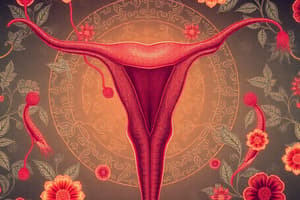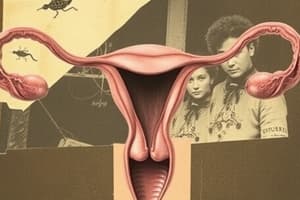Podcast
Questions and Answers
Where does spermatogenesis occur in the male reproductive system?
Where does spermatogenesis occur in the male reproductive system?
- Prostate gland
- Vas deferens
- Epididymis
- Seminiferous tubules (correct)
Which cells are the precursors to sperm cells in spermatogenesis?
Which cells are the precursors to sperm cells in spermatogenesis?
- Spermatogonial stem cells (correct)
- Secondary spermatocytes
- Spermatids
- Primary spermatocytes
What process do primary spermatocytes undergo in spermatogenesis?
What process do primary spermatocytes undergo in spermatogenesis?
- Gametogenesis
- Mitosis
- Meiosis I (correct)
- Meiosis II
Where are sperm cells stored before ejaculation?
Where are sperm cells stored before ejaculation?
Which part of the brain is closely involved in regulating spermatogenesis?
Which part of the brain is closely involved in regulating spermatogenesis?
What is the role of the follicle-stimulating hormone (FSH) in male reproduction?
What is the role of the follicle-stimulating hormone (FSH) in male reproduction?
What causes the penis to become firm and erect during the process of erection?
What causes the penis to become firm and erect during the process of erection?
What is the function of luteinizing hormone (LH) in male reproduction?
What is the function of luteinizing hormone (LH) in male reproduction?
What is the main role of the acrosome in mature sperm cells?
What is the main role of the acrosome in mature sperm cells?
What maintains the specific environment within the testes for spermatogenesis?
What maintains the specific environment within the testes for spermatogenesis?
Flashcards are hidden until you start studying
Study Notes
Male Reproduction
Male reproduction is the process by which a male organism produces and contributes to the development of an embryo. It is a complex process that involves the production of sperm, their transport through the male reproductive system, and the fusion of sperm with an egg in the female reproductive system. Let's explore the key aspects of male reproduction, with a particular focus on spermatogenesis.
Spermatogenesis
Spermatogenesis is the process of producing sperm from spermatogonia, which are immature sperm cells found in the seminiferous tubules of the testes. This process occurs in the testes and is closely regulated by the pituitary and hypothalamus in the brain. The steps involved in spermatogenesis are as follows:
-
Spermatogonial stem cells: These cells are the precursors to sperm cells. They multiply and differentiate into more mature sperm cells.
-
Primary spermatocytes: These cells undergo meiosis I, a process of cell division that halves the number of chromosomes.
-
Secondary spermatocytes: These cells result from meiosis I and undergo meiosis II, another round of cell division that halves the chromosome number once again.
-
Spermatids: These are the immature sperm cells that have completed meiosis II.
-
Sperm: These are mature sperm cells that have undergone a process of maturation, including the addition of an acrosome and the development of a flagellum for movement.
Spermatogenesis requires a specific environment within the testes, which is maintained by the testosterone hormone produced by the testes themselves. The process is under the control of the pituitary gland, which secretes follicle-stimulating hormone (FSH) and luteinizing hormone (LH), both of which are necessary for sperm production.
Erection and ejaculation
After spermatogenesis, the sperm is transported through the male reproductive system to be ready for ejaculation. The process of erection and ejaculation involves several steps:
-
Erection: This is the process by which the penis becomes firm and erect. It is caused by the relaxation of smooth muscle in the walls of the penis's blood vessels and the dilation of blood vessels, which increases the blood flow to the penis.
-
Ejaculation: This is the process of expelling the seminal fluid, which contains sperm and other substances, from the penis. It occurs when the muscles at the base of the penis contract, forcing the seminal fluid out of the body.
Conclusion
Male reproduction is a complex process that involves the production of sperm, their transport through the male reproductive system, and the fusion of sperm with an egg in the female reproductive system. The key aspect of male reproduction is spermatogenesis, which occurs in the testes and is closely regulated by the pituitary and hypothalamus in the brain. This process involves the development of spermatogonia into mature sperm cells, which are then transported to the penis for ejaculation.
Studying That Suits You
Use AI to generate personalized quizzes and flashcards to suit your learning preferences.




